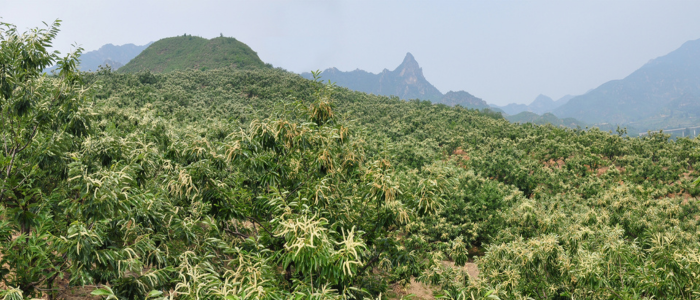Kuancheng Traditional Chestnut Eco-Planting System in Hebei Province, China
GIAHS since 2023

Global Importance
The total number of local chestnut varieties accounts for more than one-tenth of the total in China. Therefore, Kuancheng Traditional Chestnut Eco-Planting System has become an important part of the chestnut germplasm bank in China as well as around the world with its precious resources of ancient trees and chestnut varieties.
Kuancheng Traditional Chestnut Eco-Planting System is a typical model of sustainable ecological agriculture that is fully adapted to the natural and social environment prevailing in the mid-latitude mountainous area featuring vast areas and complex terrain. It sets an important example for the development of eco-agriculture in a mountain area with a semi-arid and semi-humid climate in the world.
Food and livelihood security
The chestnut-based agricultural production occupies an important position in the economy of Kuancheng. The flexible smallholder farming model and the efficient cooperative operation support system in the heritage system constitute a stable and highly adaptable social and economic operation mode. The income from chestnuts has been listed as one of the most important sources of household income by up to 74.3% of farmers.
Historically, chestnut, described as a “sure source of income” and “grain coming from a tree”, was one of the main food sources of local community in Kuancheng. The GIAHS system produces a variety of foods, such as chestnuts, grifola frondosa mushrooms and vegetables, thus providing a rich variety of foods for local community, improving the nutritional intake of residents, and contributing to their health.
Agrobiodiversity
There is a long history to the Kuancheng Traditional Chestnut Eco-Planting System, and a number of ancient chestnut trees are found. The number of chestnut varieties planted in Kuancheng accounts for more than one-tenth of the total chestnut varieties in China.
With chestnut as the core, the heritage system features plentiful agricultural biodiversity. The chestnut is cultivated in conjunction with fruit trees such as hawthorn, wild apricot, apple, and jujube, forming a mixed commercial forest dominated by chestnut trees. In addition, crops in the chestnut forest constitute a complex agroforestry system rich in species. Grain crops intercropped in the chestnut forests include maize, sorghum, millet, proso millet, soybean, mung bean, adzuki bean, buckwheat, potatoes, and other crops; intercropped vegetables include capsicum, pumpkin, onion, eggplant, perilla, Grifola frondosa; intercropped medicinal materials include bupleurum, salvia miltiorhiza, forsythia suspensa, herba schizonepetae, chrysanthemum, scutellaria baicalensis gorgi, and common anemarrhena rhizome, which are rich in biodiversity.
The Kuancheng Traditional Chestnut Eco-Planting System exists is in harmony with the surrounding natural vegetation and landscaping elements to create an organic body. Its natural and ecological production and management mode has little impact on natural vegetation, which is conducive to protecting the wild animals and plants in surrounding area. In addition, the abundant biodiversity in the system provides conditions for the survival of wild animals and plants.
Local and traditional knowledge systems
Local farmers have established an a chestnut cultivation knowledge system adapted to the local environment; on this basis, the ecological and economic benefits of the chestnut cultivation system is synchronously improved through the cultivation of the grifola frondosa, scutellaria baicalensis gorgi and other crops and breeding of hens and other poultry in the chestnut forest and the ecological measures to prevent and control pests by physical and biological means. On a larger scale, measures such as rational allocation of forest resources, construction of terraces and contour trenches, digging ditches along hillsides, building fish-scale pits, ponds, dams, and check dams have been implemented, promoting the effective and efficient use of water and soil resources in the mountainous area and ensuring the harmonious symbiosis between the chestnut cultivation and the natural environment.
Cultures, value systems and social organizations
The ecological view of respecting nature and the social organization structures that promote the agricultural production reflect the rich cultural connotations of the Kuancheng Traditional Chestnut Eco-Planting System. A code of conduct for protecting the natural environment and promoting the harmonious coexistence between the human and nature has been gradually established by local community in the course of history. In addition, the aspects such as clothing, dwellings, festivals, and ceremonies also show people’s respect for and adaption to nature.
In addition, the mode of the social organization formed under the influence of Eight Banners, Zhuangtou culture, and families have played a positive role in promoting the cultivation of chestnut trees and related agricultural production activities. On this basis, the cultural symbol value of chestnut has been gradually formed in the local area, which is shown in the food culture of the chestnut: the chestnut can be regarded not only as a staple food but also fruit and also as a medicine. The chestnut is seen locally as the spiritual symbol of auspiciousness and determination and chestnut-related legends, stories and literary works, as well as ancient chestnut trees serve as historical and cultural symbols.
Landscapes and waterscapes features
From a spatial perspective, the Kuancheng Traditional Chestnut Eco-Planting System consists of “woodlands/shrubs-chestnut forests-farmlands-villages-waters” as described in the GIAHS Proposal Kuancheng Traditional Chestnut Eco-Planting System.
The farmlands are in flat valleys around the villages, including paddy field, dry land, and irrigated land. Chestnut forests are distributed on the foothills and the lower parts of hillsides. Woodlands and shrublands are distributed in the upper parts of the hillside which are not suitable to cultivate crops and commercial tree species.
The chestnut forests in the heritage system are scattered all over the mountains, and the landscape features are quite different in different seasons, presenting great aesthetic value.

